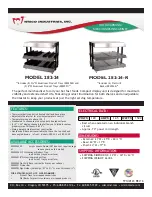
2
Important Cord Information
This appliance has a polarized plug (one blade is wider than the other). To reduce the risk of electric shock, this plug is intended to
fit into a polarized outlet only one way. If the plug does not fit fully into the outlet, reverse the plug. If it still does not fit, contact a
qualified electrician. Do not attempt to modify the plug in any way.
A short power supply cord is provided to reduce the risk of becoming entangled in or tripping over a longer cord. An extension cord
may be used if care is properly exercised in its use. If an extension cord is used, the marked electrical rating of the extension cord
should be at least as great as the electrical rating of the appliance. The extension cord should be arranged so that it will not drape over
the countertop or tabletop where it can be pulled on by children or tripped over unintentionally.
Connect the power supply cord to a 120VAC electrical outlet.
Before First Use
• Remove the food warmer cover and lift the Mason
jar out of the food warmer base (Fig. A).
• Attach the carry handle to the base. Simply snap
the handle tabs into the base holes (Fig. B). The
handle attachment is permanent. Do not try to
remove it once it is attached.
• Wipe the food warmer base, inside and out, with a
damp cloth.
CAUTION!
To prevent electrical shock and
damage to the food warmer, never immerse the
food warmer base in water or any other liquid.
• Wash the Mason jar, lid, band, and food warmer
cover in warm, soapy water. Rinse and dry. If
washing in the dishwasher, place the cover on the
rack farthest from the heating element.
Preparing Jars for the Food Warmer
Important:
The unit heats food; it is not designed to
cook food. Food must be precooked before adding it to
the jar(s).
• Any quantity of food can be placed and heated in
the jar, up to ½ inch below the rim (about 14 oz).
This will allow for food expansion during heating.
• Filled jars can be taken directly from the
refrigerator and heated; there is no need to allow
the jars to warm up. Frozen food should be thawed
before heating in the jar warmer.
• Suggested foods to heat in your food warmer include soups, stews, chili, casseroles, scrambled eggs, stir fry, leftovers, and veggies.
• Prepare meals ahead of time and prefill wide-mouth, pint-size Mason jars with cooked food. Place lids on jars and secure with
bands. Store filled jars in the refrigerator.
How to Use in a Stationary Position (at work, school, or home)
1. Insert a closed wide-mouth, pint-size jar of precooked food into food warmer base. Never place food directly in the food warmer
liner (Fig. A). Twist food warmer cover onto base until secure.
CAUTION!
To prevent burns, do not heat an unopened can of food in the food warmer.
2. To transport the food warmer, wrap cord around base. Secure utensils under the storage band on the carry handle. If desired,
place a napkin or packets of condiments, seasonings, or crackers in the snap-open storage area (Fig. A). Pack a hot pad and/or
paper towels for use after food is heated.
Note:
When traveling with the food warmer, if travel time exceeds 20 minutes, it is recommended the jar or food warmer be
placed in a cooler while in transit. If you want to heat the food during travel, see page 3 for instructions on using it in a vehicle.
3. Keep food chilled until ready to heat. Once ready, unwrap the cord from the base.
Fig. B
Food warmer base
Wide-mouth,
pint-size Mason jar*
Carry handle
Built-in cord wrap
Hole
Utensil storage band
Storage area
Food warmer
cover
Power light
Fig. A
Tabs
Band
Liner
Lid
* One jar is included. This jar should
not be used for canning.






















